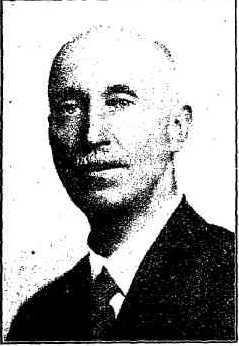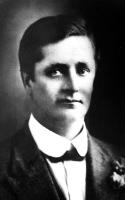martin Peter hansen (1874-1932) -
director of education

Born to Danish immigrants, Martin P Hansen worked as a teacher and headteacher for many years in both state and private schools before becoming the chief inspector of schools in Victoria and later director of education.
Hansen's achievements as an education administrator during Australia's worst years of depression were highly respected within education circles.
Hansen's achievements as an education administrator during Australia's worst years of depression were highly respected within education circles.
Early years
 John Lemmon
John Lemmon
Martin Peter Hansen was born on January 24 1874 in Crosby, near Heathcote, Victoria. His parents were Danish immigrants from Schleswig, his father was Hans Truelsen Hansen, a farmer, and his mother Caroline (nee Hollander).
Martin was educated at Tooleen State School and was awarded a scholarship to Scotch College in Melbourne. In November 1890 he matriculated and worked as an unpaid junior teacher at Abbotsford primary school. He obtained his Trained Teacher's Certificate from The Teaching Institute in 1892 after which he was appointed head teacher at Cochranes Creek school.
He then went on to teach at University High school for a couple of years after which he had several head teacher positions in schools in Gippsland and on the Bellarine Peninsula. During this time he obtained a BA and an MA and took on a position at Wesley College in 1900 where he began as a sports master and later as a teacher of natural science. In 1900 he also married Margaret Morgan, manager of a coffee palace in Warrnambool, with whom he later had a son.
Other than teaching, Martin wrote textbooks on physics for schools and helped found the Association of Secondary School
Teachers in Victoria. Outside of work, Martin was involved in athletics, as the president of the Wallaby Club, as well as being a member of various mens' dining, wine and literary clubs.
In February 1909, Martin was appointed inspector of registered teachers and schools at the Education Department and later in the year, he was promoted to chief inspector under the directorship of Frank Tate. One of Martin's key areas of interest was trialling the 'platoon' or notary system of organisation of schools replacing one secondary multi course establishment with a dual system of secondary and technical schools. Martin also explored the use of technologies, at the time unheard of in education, such as moving pictures, radio broadcasts and gramophones in schools.
From 1925, Martin was assistant director of education and succeeded Tate as director in 1928. Unfortunately, with the onset of the Depression and subsequent cutbacks, many new proposals were shelved. A strenuous work relationship with the minister of education, John Lemmon (who was against multi-purpose schools), as well as the chief inspector of secondary schools, Donald Clark, had a detrimental effect on Martin's health. In April 1932 he became ill and despite returning briefly later in the year, he had a relapse and died at his home in Toorak on December 11, 1932.
Martin was educated at Tooleen State School and was awarded a scholarship to Scotch College in Melbourne. In November 1890 he matriculated and worked as an unpaid junior teacher at Abbotsford primary school. He obtained his Trained Teacher's Certificate from The Teaching Institute in 1892 after which he was appointed head teacher at Cochranes Creek school.
He then went on to teach at University High school for a couple of years after which he had several head teacher positions in schools in Gippsland and on the Bellarine Peninsula. During this time he obtained a BA and an MA and took on a position at Wesley College in 1900 where he began as a sports master and later as a teacher of natural science. In 1900 he also married Margaret Morgan, manager of a coffee palace in Warrnambool, with whom he later had a son.
Other than teaching, Martin wrote textbooks on physics for schools and helped found the Association of Secondary School
Teachers in Victoria. Outside of work, Martin was involved in athletics, as the president of the Wallaby Club, as well as being a member of various mens' dining, wine and literary clubs.
In February 1909, Martin was appointed inspector of registered teachers and schools at the Education Department and later in the year, he was promoted to chief inspector under the directorship of Frank Tate. One of Martin's key areas of interest was trialling the 'platoon' or notary system of organisation of schools replacing one secondary multi course establishment with a dual system of secondary and technical schools. Martin also explored the use of technologies, at the time unheard of in education, such as moving pictures, radio broadcasts and gramophones in schools.
From 1925, Martin was assistant director of education and succeeded Tate as director in 1928. Unfortunately, with the onset of the Depression and subsequent cutbacks, many new proposals were shelved. A strenuous work relationship with the minister of education, John Lemmon (who was against multi-purpose schools), as well as the chief inspector of secondary schools, Donald Clark, had a detrimental effect on Martin's health. In April 1932 he became ill and despite returning briefly later in the year, he had a relapse and died at his home in Toorak on December 11, 1932.